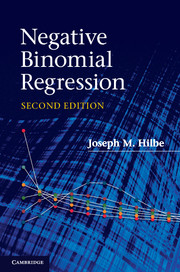Book contents
- Frontmatter
- Contents
- Preface to the second edition
- 1 Introduction
- 2 The concept of risk
- 3 Overview of count response models
- 4 Methods of estimation
- 5 Assessment of count models
- 6 Poisson regression
- 7 Overdispersion
- 8 Negative binomial regression
- 9 Negative binomial regression: modeling
- 10 Alternative variance parameterizations
- 11 Problems with zero counts
- 12 Censored and truncated count models
- 13 Handling endogeneity and latent class models
- 14 Count panel models
- 15 Bayesian negative binomial models
- Appendix A Constructing and interpreting interaction terms
- Appendix B Data sets, commands, functions
- References and further reading
- Index
Appendix A - Constructing and interpreting interaction terms
Published online by Cambridge University Press: 05 June 2012
- Frontmatter
- Contents
- Preface to the second edition
- 1 Introduction
- 2 The concept of risk
- 3 Overview of count response models
- 4 Methods of estimation
- 5 Assessment of count models
- 6 Poisson regression
- 7 Overdispersion
- 8 Negative binomial regression
- 9 Negative binomial regression: modeling
- 10 Alternative variance parameterizations
- 11 Problems with zero counts
- 12 Censored and truncated count models
- 13 Handling endogeneity and latent class models
- 14 Count panel models
- 15 Bayesian negative binomial models
- Appendix A Constructing and interpreting interaction terms
- Appendix B Data sets, commands, functions
- References and further reading
- Index
Summary
Interaction terms play an important role in statistical modeling. However, it is a topic that relates to regression models in general and not specifically to count models. The subject was, therefore, not addressed in the text. On the other hand, there are few sources that provide specifics on how interactions are to be constructed and interpreted for non-linear models, and in particular for count models. This appendix provides a brief overview of interactions and their construction.
Recall that there are a variety of types of predictors. The three most common are binary (1/0), categorical (1, 2,…, k), and continuous. Continuous predictors are often constrained to have positive real numbers as allowable values. In addition, continuous predictors that do not begin at zero or 1 are usually centered, as discussed in Section 6.3.1 the text.
Many researchers believe that the coefficients of interaction terms are interpreted in the same manner as other predictors in a model. However, this is not the case, and in particular it is not the case for interactions in discrete response regression models.
I shall provide a brief overview of how to construct and interpret Binary × Binary, Binary × Continuous, Categorical × Continuous, and Continuous × Continuous interactions. These appear to be the most commonly employed interactions. Understanding these allows the construction and interpretation of any of the other options.
- Type
- Chapter
- Information
- Negative Binomial Regression , pp. 520 - 529Publisher: Cambridge University PressPrint publication year: 2011



